Lecture 20: Community Ecology: predation, disease, and parasitism
1/36
There's no tags or description
Looks like no tags are added yet.
Name | Mastery | Learn | Test | Matching | Spaced |
|---|
No study sessions yet.
37 Terms
What types of interactions involve an organism consuming all or part of another animal?
Carnivory (predation)
Herbivory (grazing)
Parasitism (disease)
What are some characteristics of predation?
prey is usually killed
predator is usually larger than the prey
there’s multiple prey per predator
What are some characteristics of herbivory?
plants usually survive
What are some characteristics of parasitism?
hosts may or may not survive
the host is usually larger than the parasite
there can be multiple parasites per host
What is an example of parasitism?
Ascaris Worms.
It has infected about 1 billion humans.
What is an example of parasitism in vertebrates?
Brood Parasites.
Brood parasitic birds are birds that lay their eggs in other birds species’ nests. This is to avoid the costs of parental care.
Sometimes the brood parasites are so successful that the host bird will breed and care for the offspring of the brood parasite.
*See image, where another bird species is feeding the offspring of the brood parasite.
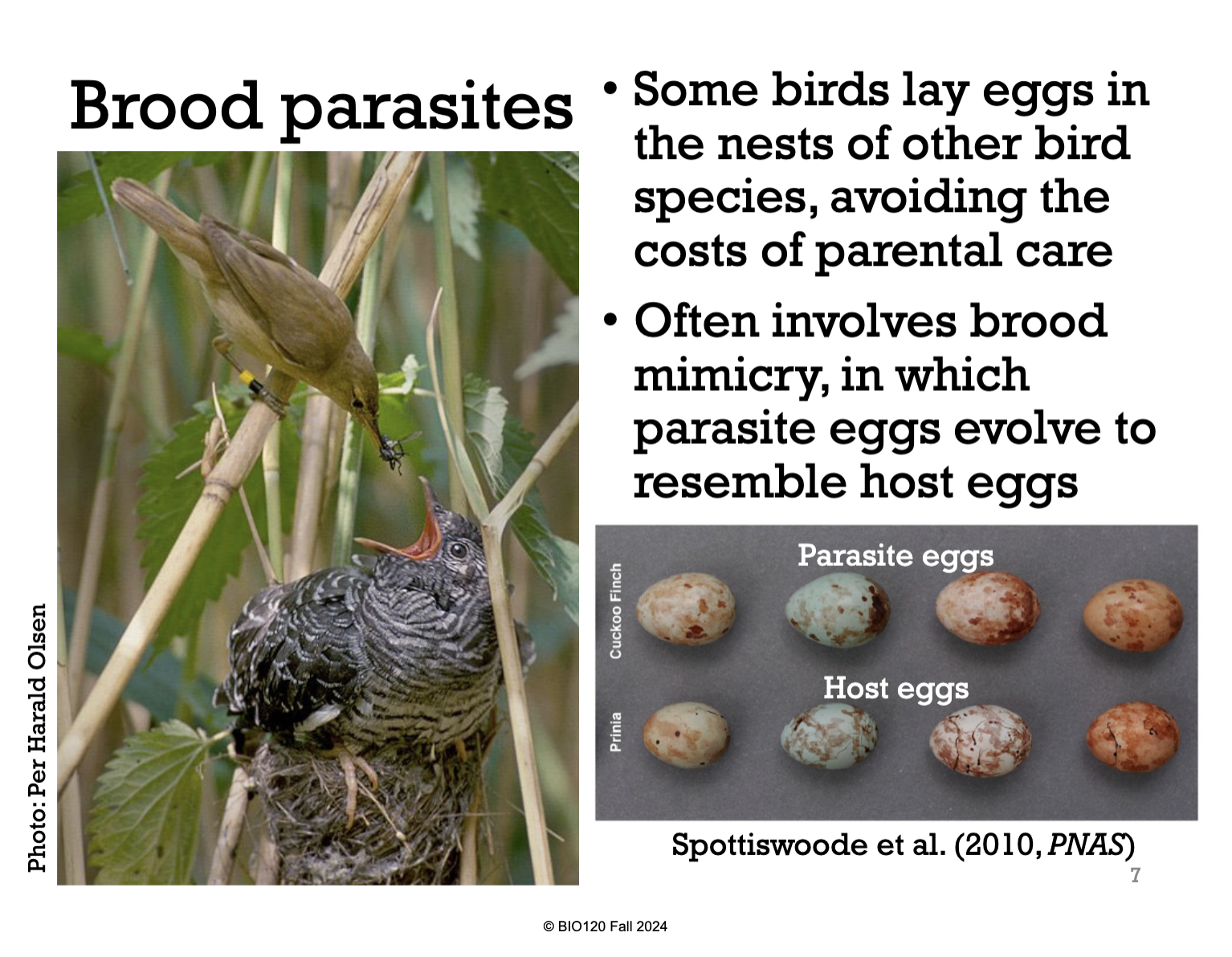
What often happens as a result of brood parasitism?
The parasitic eggs will evolve to look like the host eggs so that the host birds can’t tell which one is their offspring and which one isn’t.
This increases the chance that the host won’t realise that they are taking care of someone else’s baby.
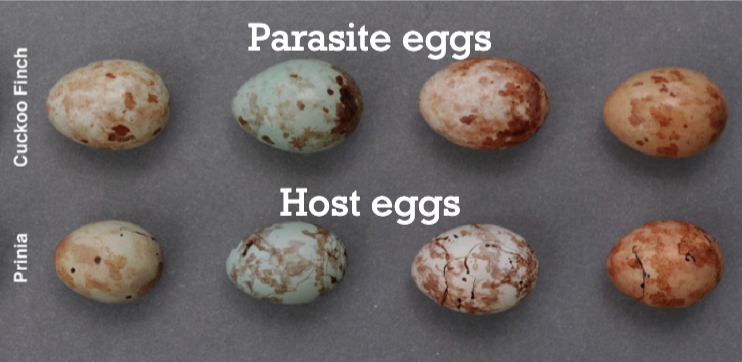
What do Lotka-Volterra models for predator-prey interactions predict?
They predict coupled, lagged, population cycles.
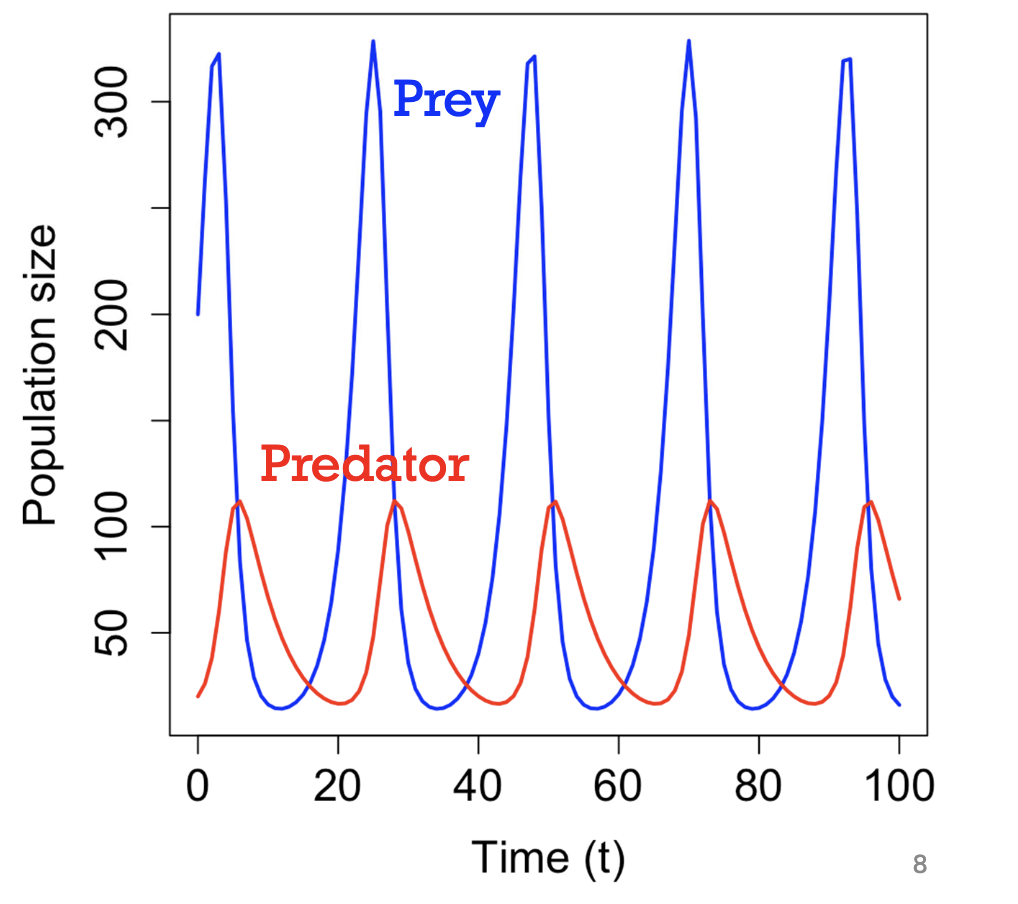
Why does the Lotka-Volterra predator-prey model predict a coupled, lagged, population cycle?
when there’s a lot of predators, they eat a lot of prey. Hence, the prey population declines.
as the prey population declines, they get scarce and so the predators don’t have enough food. So the predator population starts to decline.
with fewer predators, the prey population increases (recovers)
however, as the prey population increases, there’s more food for the predators and so their population increases (it recovers)
*that’s why populations “cycle”
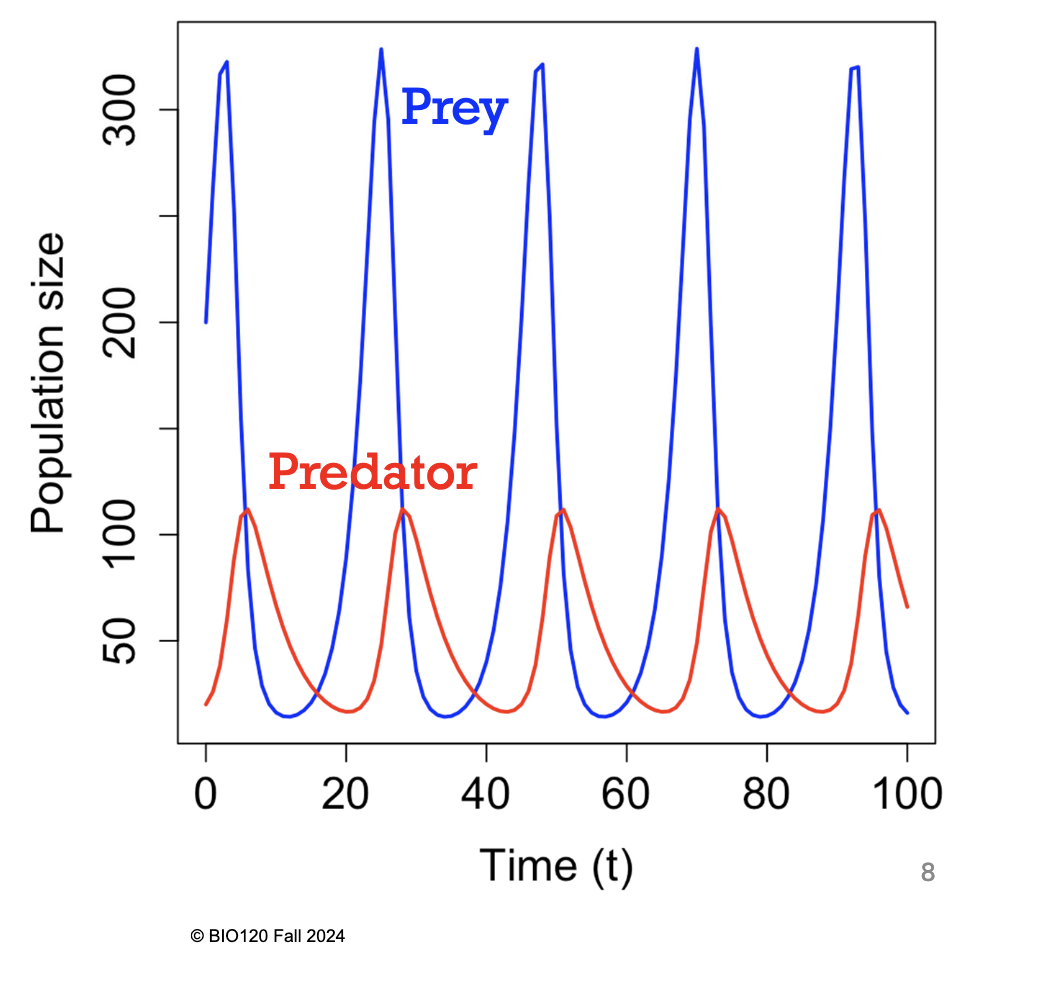
Do cycles occur in real populations?
Yes.
What is an example of a cycle in real life?
In 1958, Huffaker did a study on 2 mite species. The first being the herbivorous six-spotted mite on orange trays and a predator mite. A tray of oranges was provided so that the six-spotted mites would be distracted from the predator mites.
In the lab, 3 cycles identified.
When the population of the six-spotted mice were high, there was lots of prey for the predator mites to eat so the population of the predators increased.
As a result, the population of six-spotted mites (prey) decreased.
Then, the population of the predators decreased because the population of its prey got so scarce.
This then allowed the six-spotted mite to recover (its population increased again).
That means more food for the predator, allowing its population to recover…
*and so on… the cycle continues
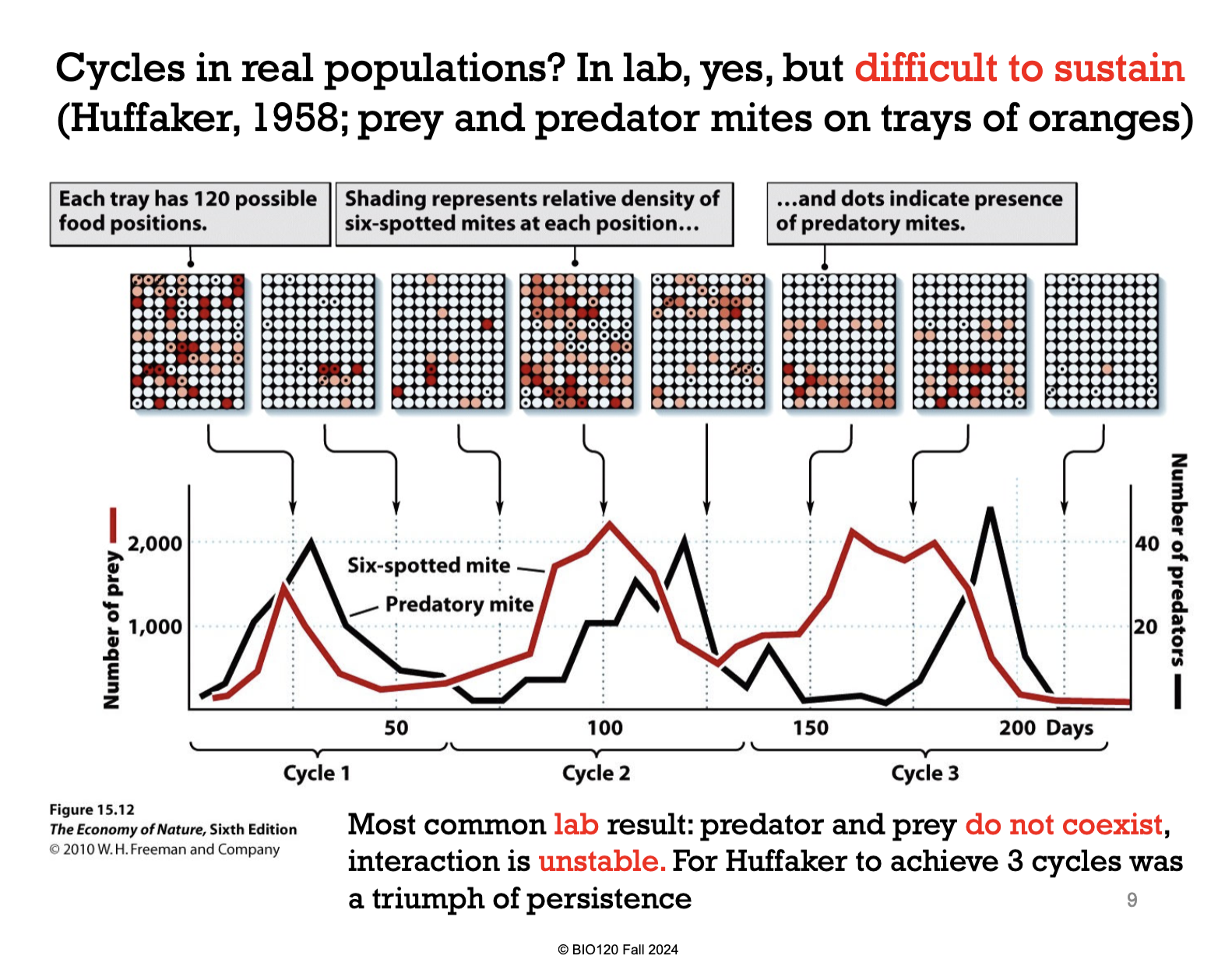
What is the most common lab result for predator-prey interactions?
The predator usually eats all the prey and then starves to death. Hence, indicating that predators and prey do not coexist and that the interaction is unstable.
Hence, for Huffaker to document 3 cycles is amazing.
How did the Hudson’s Bay company contribute to documenting one of the most famous cycles outside of a lab?
The amount of lynx and snowshoe hare pelts sold by the Hudson’s Bay company was used to estimate the population size of the 2 species over 1845-1935.
Hence, helping distinguish whether the lynx and snowshoe hare populations cycled.
Did the populations of Lynx and Snowshoe Hare cycle?
Yes. 9 cycles were found.
*for the same reasons as written above
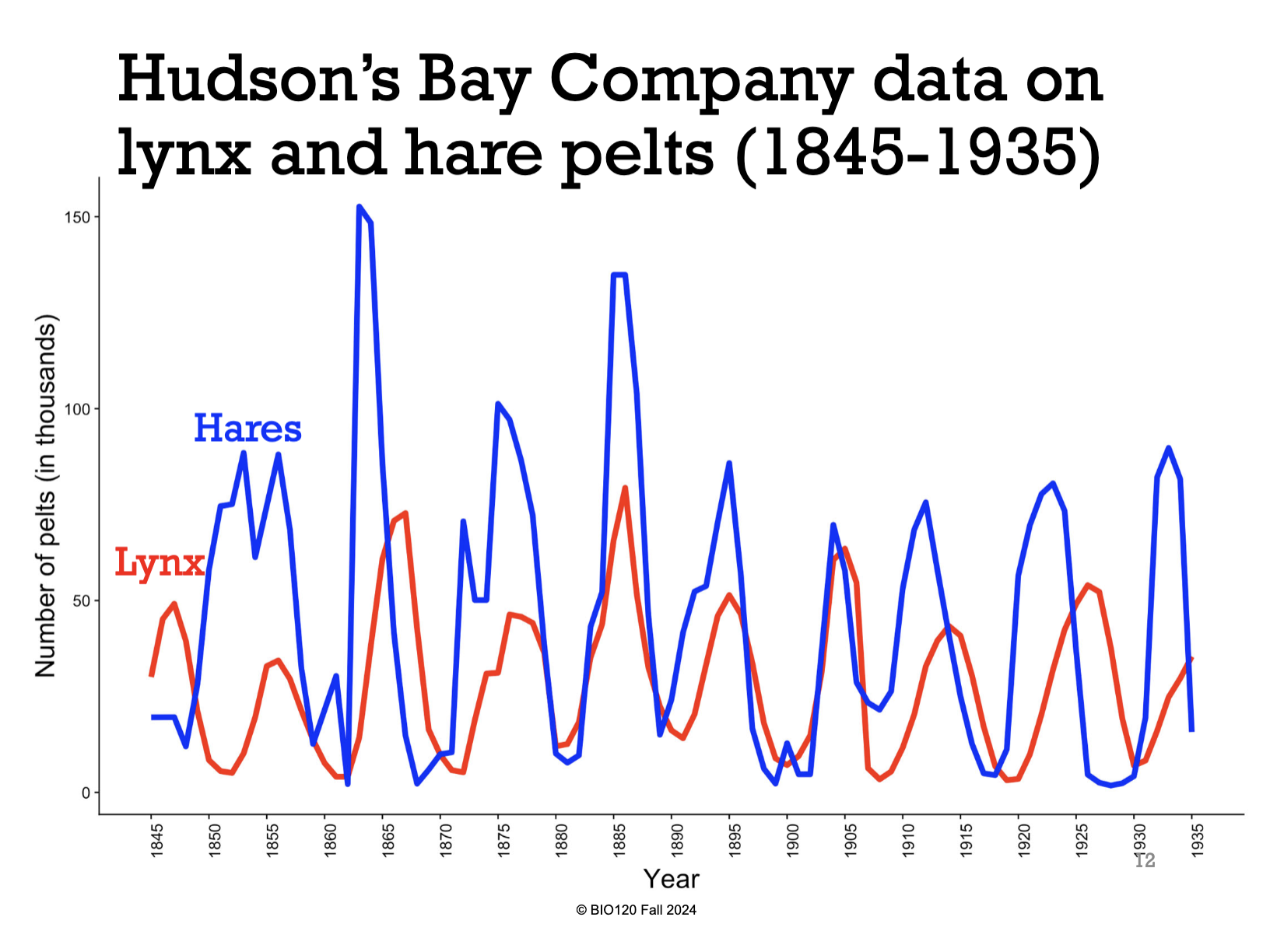
Are cycles in nature common?
No.
Why are cycles uncommon in nature?
Most predators eat multiple prey. Hence, they’re less likely to run out of food even if their prey population decreases.
So why does the Lynx and Snowshoe Hare show so many cycles?
The results seen are likely to due to a combo of factors.
Heavy herbivory
decreases the quality of plant food that hares can eat. Hence, this cycle that we notice may be due to the cycle of plants
Overcrowding in hare populations
make the Hares stress, which messes with their hormones and thus the amount that they reproduce. Hence, the cycles might be a response to stress, rather than just predation.
What is an example of disease cycles?
Measles before vaccination.
Measles tended to cycle in the human population. This wasn’t because Measles were causing a high mortality rate in humans. Hence, with less ‘prey’ (humans) the Measles virus began to die and the human population increased.
INSTEAD, when many people got infected, those infected would recover and become immune (which lasts for your whole life). Hence, the Measles could not infect those people anymore.
So for another outbreak year to occur, enough babies would have to be born for the Measles to affect the population again.
Therefore, it was the change in number of susceptible and immune humans in the population that affected the cycles.
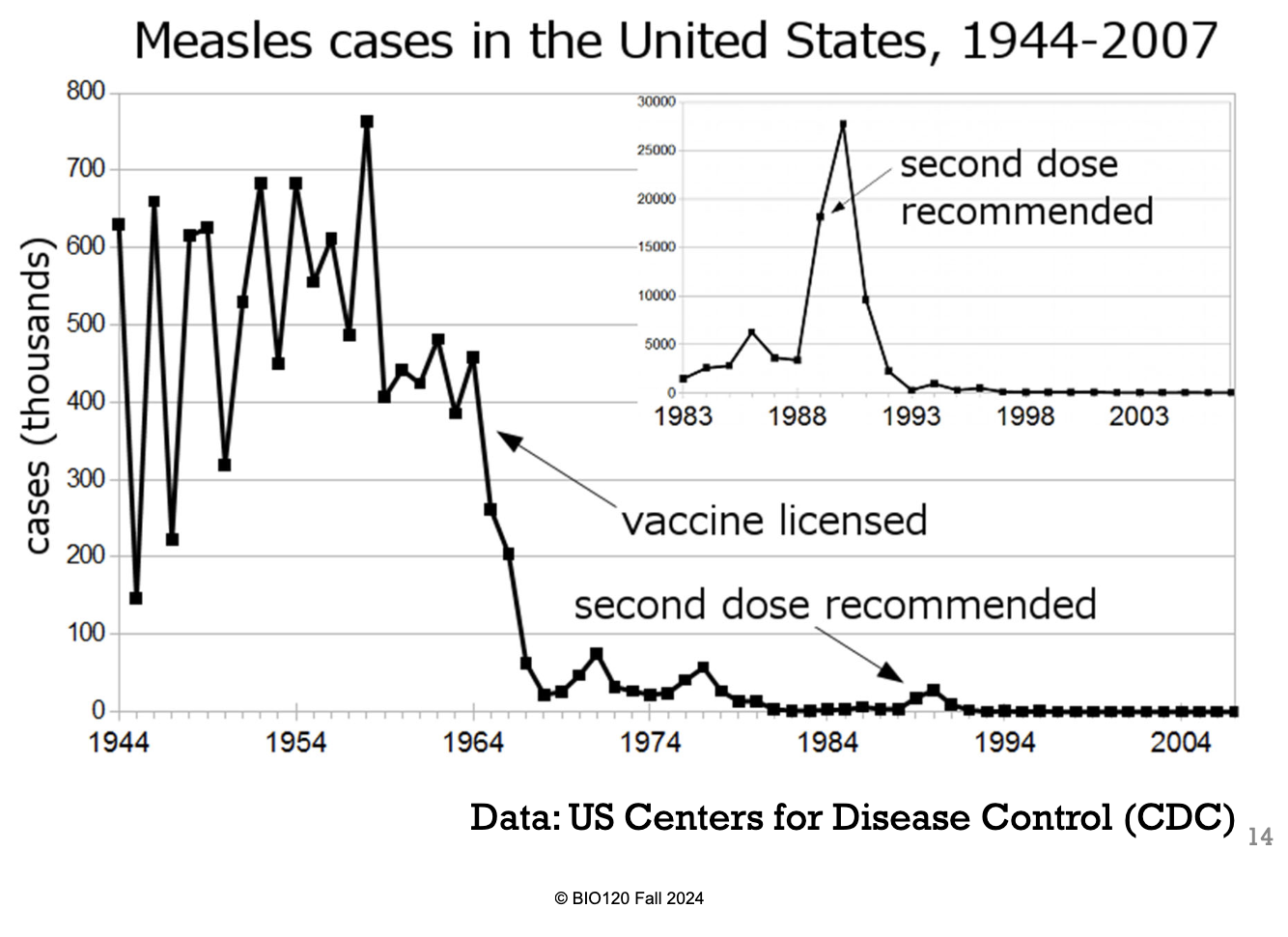
What are the evolutionary implications of predator-prey interactions?
Leads to antagonistic co-evolution.
Define antagonistic co-evolution.
When species reciprocally adapt. For example, if predators and their prey are antagonistically coevolving, while the prey evolves defences to its predator, the predator evolves new adaptations to overcome to new defences.
This is also known as an “arms race.”
Define the “Red Queen Hypothesis.”
We think that prey are evolving a fast as they can to defend themselves against their predators.
At the same time, we think that predators are evolving as fast as they can to adapt to the new defences of their prey.
Hence, from an outside point of view, there doesn’t seem to be much change because both are evolving at the same rate, and no net change is being made.
What is an example of antagonistic co-evolution?
Garter Snakes and Rough Skinned Newt.
Newts form a strong poison called Tetradotoxin (TTX) as a defence mechanism. As a response, Garter snakes have evolved resistance to TTX.
In the image you can see that as TTX gets more poisonous, the Gartner snakes become more resistant to TTX. There is a linear relationship between the evolving nature of the two.
Hence, yes there is a change. But there is no net change. This is what the “Red Queen Hypothesis” was trying to explain.
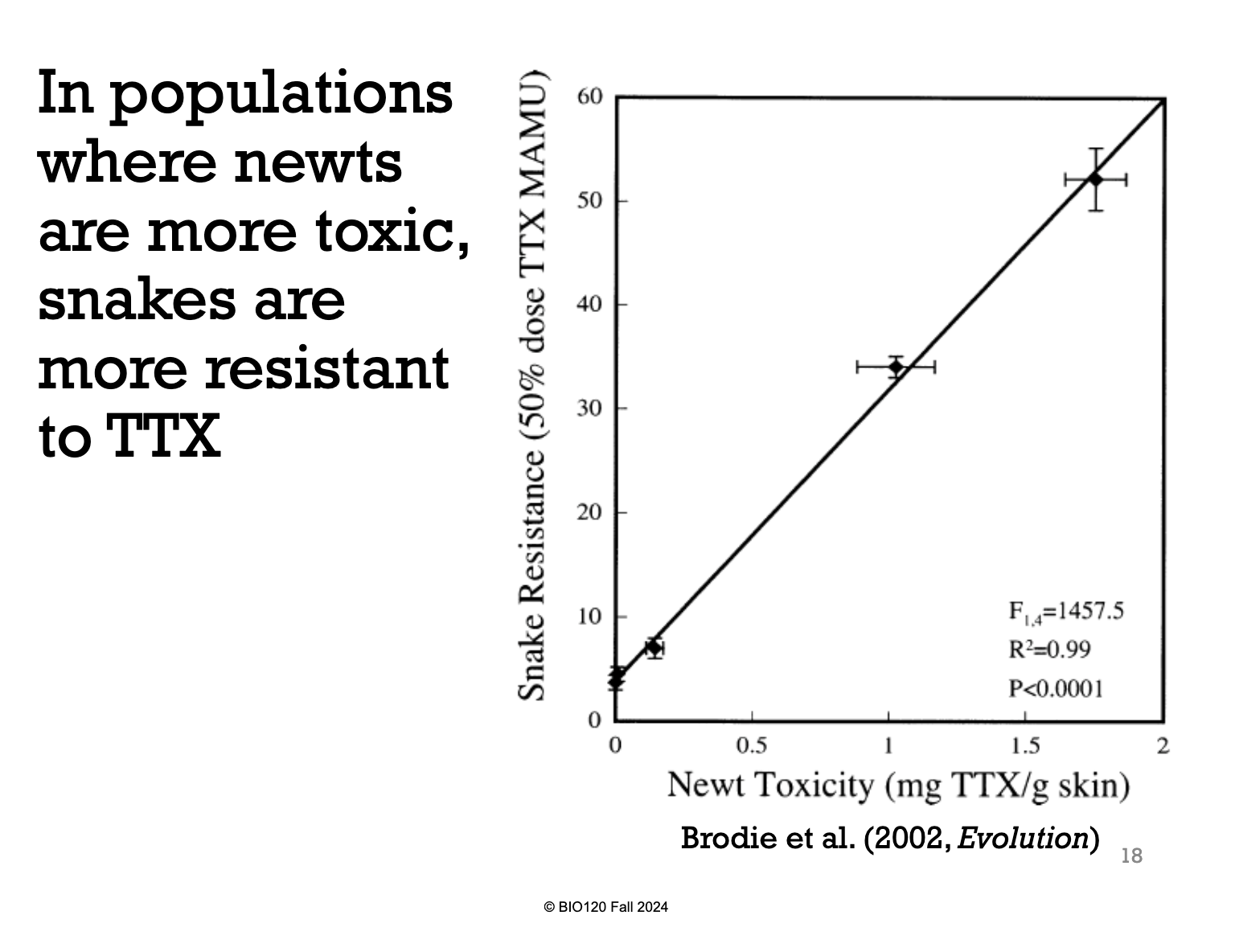
What is the difference between an arms race and the “Red Queen Hypothesis?”
An arms race talks about rapid evolution between predator and prey species as a result of their interactions.
Whereas, the “Red Queen Hypothesis” talks about the balancing of the evolutionary adaptations of the two species causing no real net change in either’s dominance over the other.
What is the life-dinner principle?
The principle highlights that there are inherent unequal selection pressures on prey and predators.
The principle thinks that prey are under stronger selection for defences because the consequences of not having adequate defences costs them their lives.
Whereas, predators are under weaker selection for overcoming their prey’s new defences because it doesn’t cost them their lives.
*read this quote, it explains this idea perfectly.
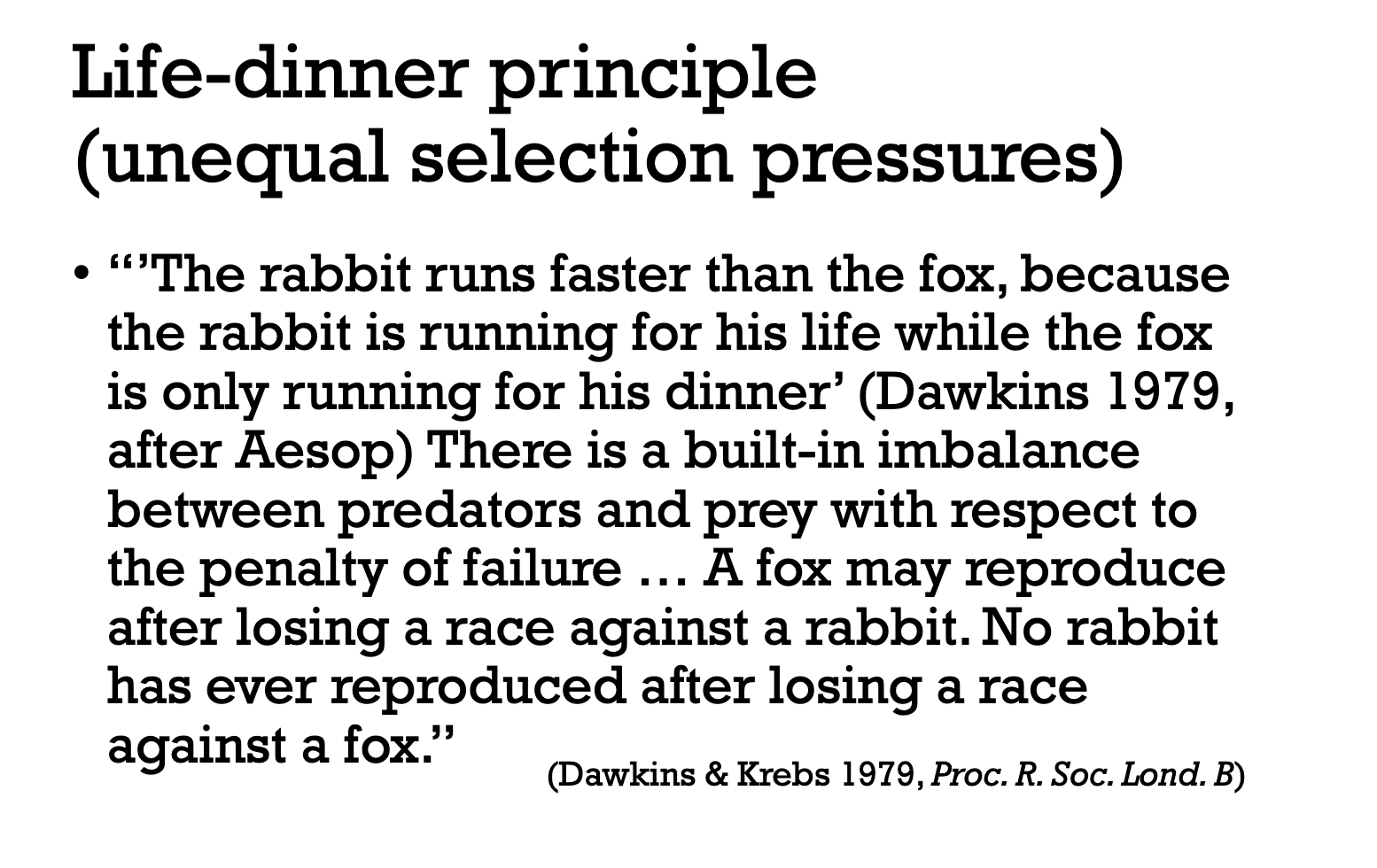
What is an example of predation affecting community structure?
Robert Paine’s Pisaster (Sea Star) study.
Paine tried to understand how predation on Mussels by Pisaster Sea Stars affected the intertidal zones’ community structure.
He set up many plots. In the plot where everything was left alone, he noticed that the invertebrate and algae population did not really change over time.
However, when Pisaster Sea Stars were removed, he noticed that the invertebrate and algae population dramatically decreased where Mussels were basically the only thing left.
This happened because Mussels are superior predators and so, without Pisasters eating them, they can dominate the intertidal zone and rid it of other invertebrate and algal species.
Hence, Pisasters were preventing Mussels from out-competing other invertebrates and algal species, helping maintain biodiversity in the intertidal zone.
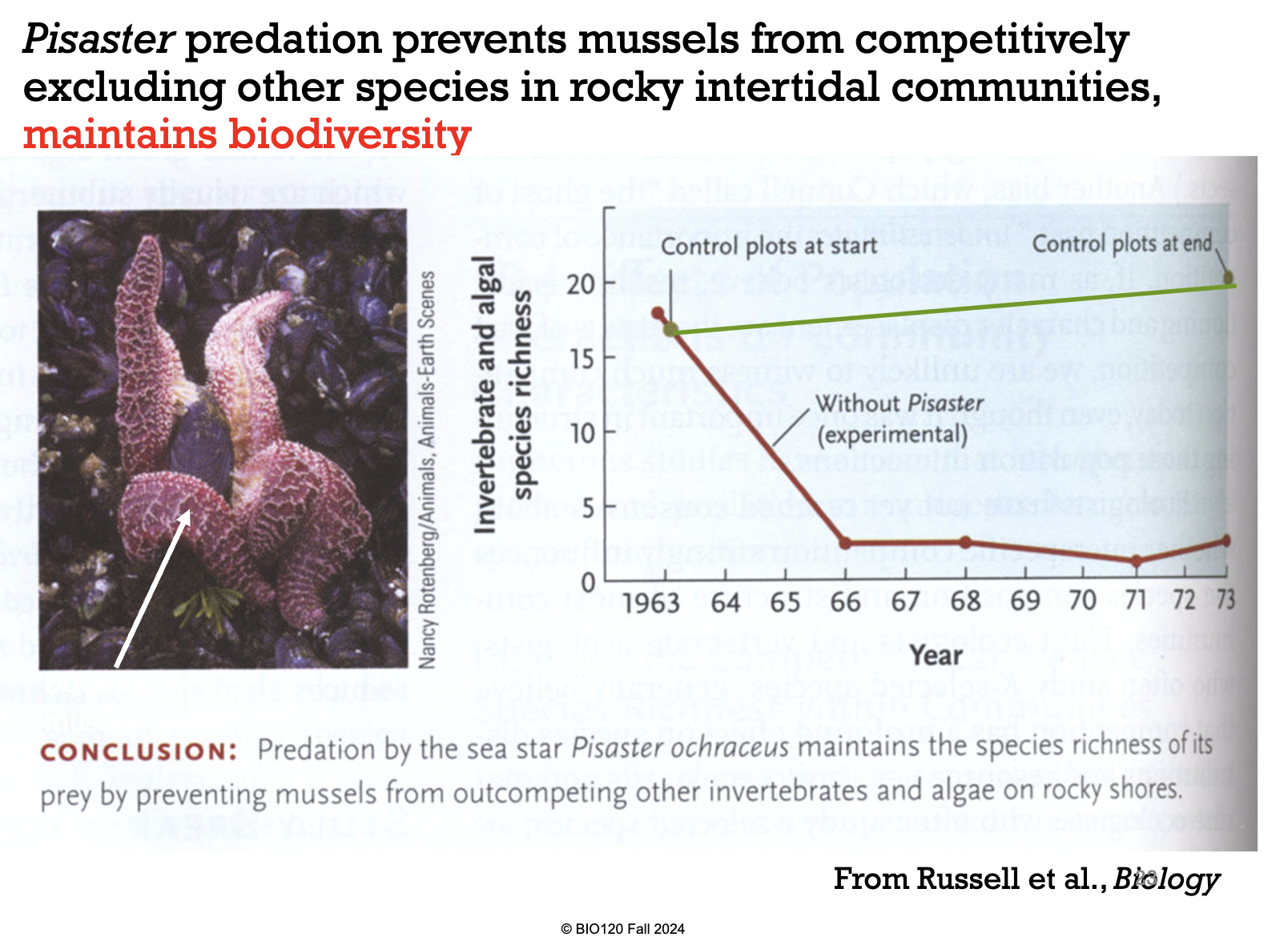
Define community structure.
Which and how many species live in a community.
Why do invasive species reach higher population sizes, in new non-native ranges, than the original population residing in that area? Also, why are they such pests in the new range, but not in their original homes?
This is due to the Enemy Release Hypothesis.
The hypothesis states that invading species become such pests because they have fewer natural enemies in their new range than their native range. Hence, they are not ‘regulated’ anymore.
What is an example of the Enemy Release Hypothesis?
In the graphs you can see that the number of pathogens in the fungi back in their native range is about 4. Whereas, when they go to North America (naturalised) range, the number of pathogens decreases to about 1.
This is a good example of the enemy release hypothesis because it shows how the fungi left behind its enemies (pathogens) when going to North America, allowing them to be very successful in their new range.
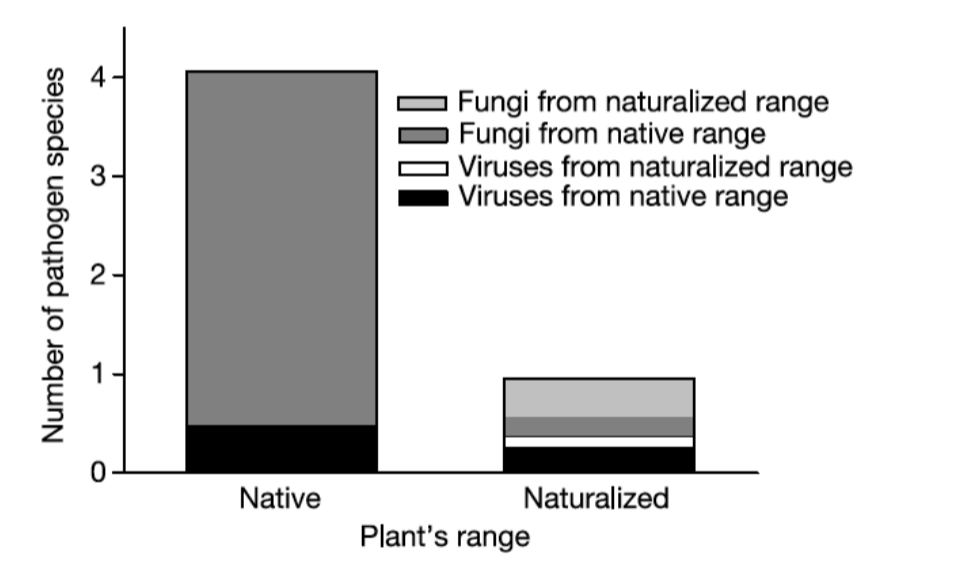
Define a complex life cycle.
When parasites require 2 or more host species to complete their life cycle (ie. Malaria).
Define vectors.
Hosts that transport parasites to their next host.
Define zoonotic diseases.
Diseases transferred between animals and humans.
Define reservoirs.
The host species of diseases transferred from animals to humans.
What affects parasite abundance and transmission?
Distribution (where is it - native?)
Life history traits
Behaviour of the host
What are the 2 competing ideas of community ecology of disease?
Dilution Effect
diseases that affect many hosts is good because it dilutes the disease risk to humans or animals
Amplification
more host or vector species is bad because it can support larger populations of disease causing organisms, increasing disease risk to humans or animals
What is an example of the amplification effect?
Malaria.
They studied a Malaria causing parasite that is vectored by many different species of mosquitoes. They wanted to know if the diversity of mosquito species could help predict the risk of Malaria in children.
They found that communities with more diversity in mosquito species had a higher prevalence of Malaria in children. Thus, a positive relationship was identified.
This is thus an example of the amplification effect because more hosts/vector species increased disease risk.
What is the latitudinal gradient in species richness?
The idea that there are more species near the tropics than there are near the poles.
*true for almost everything
Is the latitudinal gradient in species richness the same for human pathogens?
Yes, there are more variations in human pathogens by the tropics than there are in the poles.